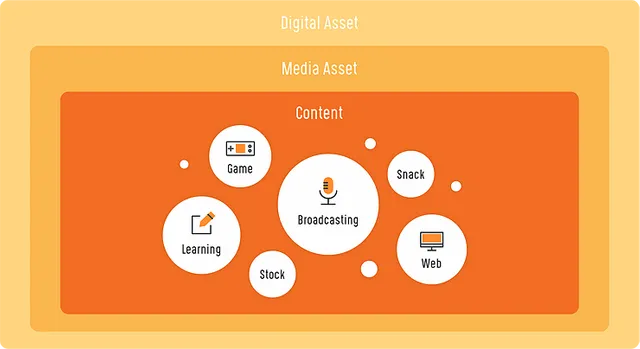What is Media Asset?
Hello. I’m Lee, taking in charge of this topic What is Media Asset?. I was a content creator making Films, Music videos, and Advertisements, and based on my life and experience as a creator, I participated in the planning/development of OvenAsset and OvenCloud Pro, the Digital Asset Management (DAM, hereafter) or the Media Asset Management (MAM, hereafter) of AirenSoft. They needed the judgment of a creator who could say, “This function is necessary. It should be developed more!” for the development of more advanced DAM/MAM. But, just like everything else, it didn’t go smoothly. I only knew the method to create content while I didn’t know the process of developing a solution or service. Even though I thought that I was fully aware of the video, I was conceptually insufficient, so that I needed to study a lot more. From now on, I will tell you about what I have learned and understood while participating in the producing of DAM/MAM, under this topic. Well, it’s not all, but just a little bit.
What are Property and Asset?
Everyone has a rough idea of the media asset. But, it’s hard to tell exactly “Hey! listen carefully, the media asset is this!” This is applied to me as well. So, before talking about media asset, we should know about the general concept of property and asset first.A long time ago, people bartered like exchanging an object with another with equal value to get necessary objects. From this time, people set and gave values to objects in accordance with the degree of necessity. As people’s interest gets diversified and the value is expanded in the current era, the asset is basically classified as follows.
- Realty: Unmovable property like land, house, and building.
- Chattel: Movable property like money, car, and equipment.
- Intellectual property: Creation like design, music, and literature.

What are Digital Asset and Media Asset?
Hey, guys, please pay attention to this. I aim to talk about not just an asset, but media asset. In fact, before talking about media asset, we should understand digital asset in a bigger scope. The digital asset is the digitalized asset. Currently, lots of data have been digitalized such as:
- Account information including personal information.
- Computer-written or Scanned documents.
- Videos, Images, and Music files made by creators.
- Software development codes and Databases.
- More.
Owing to the development and spread of digital devices, everyone can easily produce, save, and share data anytime and anywhere, which is such a natural daily life to us.
All the digitalized assets are generally called the digital asset. However, it includes much more things than the stuff we easily get such as Document, , Image, and Music file. Currently, all of these are generally called content that has been divided in detail in accordance with major use form. For example, the contents handled in webs like blog and internet news are the web contents, while the contents produced/distributed for education are the learning contents. The contents consumed in a specific frame (1:1 size, length around 30 seconds) like Instagram are the social contents or the snack contents. The use of contents has been much more diversified than before, which will be expanded to more types of contents.

But, there is a hidden trick here. The web contents are the document written in texts, while the learning contents are produced as video to deliver information. Social contents use image or music to attract people’s attention. In other words, contents cannot largely get out of the category of video, image, music, and document, and we call these digitalized media files media asset.
Some people call them the content asset. It’s not wrong if the results as produced contents are only collected and managed. However, in the position of creator and creation team, it’s impossible just to mention the results of all the contents in the world because all the original sources, references, and people’s ideas used for the production of content are all valuable assets.
Then, is it possible to tell all the media files as media asset?
I would love to say “Yes!”. But, unfortunately, the answer is “No”. As mentioned earlier, the property needs to have economic value. Therefore, the creative content/work/production like Film, Broadcasting, Art, Music, and Literature made by creators are classified into the property, which is called intellectual property. Thus, all the media files used for making contents created by creators not just by anyone could be called media asset.
Are you a creator? Even if you are not, don’t worry because everyone can become a creator. At this moment, I’m also a creator writing this in the blog. Why? The consumers’ values have been diversified and will be diversified than before. And, the values of all the contents are decided by consumers.
Which media asset would be more emphasized in the future out of many media assets such as Video, Image, Music, and Text?
Of course, it’s the video. Numerous channels we are always participating in such as YouTube, Vimeo, Facebook, Instagram, Twitch, and Mixer, have selected video already because videos could include all the image, music, and text with a strength of creating/showing the next scene. In other words, videos can solve the visual limitation of image, music, and text.
Let’s talk about music as an example. When listening to music “A”, someone reminds of heaven while others remind of hell because everyone has a different picture in his/her mind depending on the living environment. Some people say that it should be allowed as a part of the Experiential arts. But, most content creators want the viewers to correctly understand their intentions because that misunderstanding is usually led to harsh criticism, instead of favorable comments.
Returning to the original story of music “A”, if someone creates a video by combining the image symbolizing heaven with this music, no one would remind of hell after listening to this music. This would be applied to the novel as well. All the contents accepted to head and mind depending on the imagination of listeners/readers could cause misunderstandings. To solve this problem, images are partially used, which is too limited. Therefore, we widely use a tool called video.
Of course, there are genres like Experimental film intentionally creating misunderstandings. However, the video is the most effective tool for delivering the intentions and messages. During the web surfing, your eyes will be drawn more to the meme of GIF than the meme of JPG. Moreover, if the proper texts are placed together with sound effects, it could secure the attention and fun.
What are the problems of the video?
The problems of the video could be:
- Expertise for smooth production.
- Management of numerous used files before and after production.
If you want to produce a video, you should know about so many different things like the Resolution, Aspect ratio, Image scanning (Interlace and Progressive), Bit-rate, Frame-rate, Key-frame, Buffer, Codec, Format, and more. Moreover, in this era, simply knowing about video does not mean that you can create contents. To create content, you need to have the sense and knowledge of music, design, and literature. So, creators should view and feel much more things than others, and our hard-disc is filled with references. Where are all sorts of references, tutorials, completed works, and sources accumulated so far? It’s very difficult to manage the contents and media sources. That’s the reason why people are looking for tools for centralizing and classifying media files like MAM, Cloud, and NAS. They are tools feeling like the content butler.
Which elements should be considered to manage your precious media asset?
Depending on people’s demand, there are diverse types of MAM, Cloud, and NAS in the world. However, we cannot put our precious media assets in unverified places for management. We don’t feel secure. So, I will tell you the elements that should be emphasized when selecting MAM, Cloud, and NAS.
First, think about the process of producing and publishing content. Of course, I will use video as an example as the video is the only thing I know.
#01. Centralizing and classifying
I just listed in my thoughts, and it goes through considerably many processes. Of course, all of them could be done by oneself. However, in most cases, content is produced by a team composed of experts. At this time, the most important thing is to centralize all the sources like video, image, music, and document necessary to the production of the content, and also to classify them in each type of file, so that all your team members should be able to easily use them. Moreover, to increase the usability, it would be better to have a function of leaving the record of using this content by whom and when, and also a function of marking that indicates whether team members are using it.
#02. Not being lost
As mentioned earlier, about dozens or hundreds of sources are needed to produce content. If the centralized shooting sources are damaged or deleted, all the time, money, effort, and plan we have invested in them would come to nothing. In order to protect all the uploaded contents from damage or loss, we should check if the original file has been duplicated in the server.
#03. Not being leaked out
For the production of contents, we frequently cooperate with outside experts. In other words, before distributing the contents, they go through considerably many people. At this time, if the contents are leaked for various reasons such as mistaking the date of distribution, it will cause a huge loss to you. Even though everyone is aware of the risk of leakage, it’s hard to predict who will leak them when. Therefore, we should check if there are the measures for preventing the leakage such as the system in which outsiders can view the file only in the designated period, or the delivery of files is only allowed when the access to the whole information is blocked.
#04. Making it be used anytime and anywhere
Even if the contents are distributed once, the utilization or value does not go down. They could be mentioned/used by follow-up contents, or some of the unused sources are reusable. In other words, the utilization depends on the creators. Whenever having an idea like “It would be great to use this source for here!”, the source could be delivered to others by finding the previously-centralized & well-classified source in a web or app. If necessary, it could be roughly edited to deliver the feeling to others.
---
Surprisingly, all the stuff mentioned above are the basics of OvenAsset (On-Premise DAM) and OvenCloud Pro (Cloud-based DAM). There is detailed information on the page of OvenAsset on the homepage of AirenSoft. If you start having interest after reading it, please feel free to contact me without hesitation.
Thank you so much for reading this long writing. It has been such a pleasant experience for me to create this writing in the blog. I cannot wait to meet you again under the new topic next time.
---
Also, this post has been moved from AirenSoft Blog. If you read this article and are interested in our technology, please visit our blog.